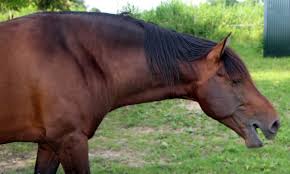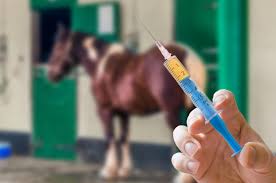Equine influenza, scientifically known as equine influenza virus (EIV), is a contagious respiratory disease that affects horses. This viral infection is caused by influenza A viruses of the H7N7 and H3N8 subtypes. Equine influenza is highly contagious among horses, and outbreaks can occur in horse populations around the world.
The virus primarily spreads through respiratory droplets when infected horses cough or sneeze. Horses in close proximity, such as those in stables or at equestrian events, are particularly at risk of contracting the virus. The incubation period for equine influenza is relatively short, usually ranging from one to five days, making it challenging to control its spread once an outbreak occurs.
Clinical signs of equine influenza include fever, nasal discharge, coughing, and general lethargy. The disease can impact the respiratory system, leading to secondary bacterial infections, which can exacerbate the severity of symptoms. Affected horses may experience a temporary decrease in performance and, in severe cases, may develop pneumonia.
Vaccination plays a crucial role in preventing and controlling equine influenza. Vaccines are available to protect horses from the most common strains of the virus. Regular vaccination schedules are recommended, especially for horses that travel frequently or come into contact with other horses.
Isolation and quarantine measures are essential during outbreaks to prevent the further spread of the virus. Infected horses should be separated from healthy ones, and stringent biosecurity protocols should be implemented to minimize the risk of transmission.
Timely detection and reporting of equine influenza cases are vital for effective disease management. Veterinarians play a key role in diagnosing and treating infected horses, and their expertise is essential in implementing control measures to contain outbreaks.
Equine influenza is a significant concern in the horse community due to its contagious nature and potential impact on equine health and performance. Through proactive vaccination, biosecurity measures, and prompt veterinary intervention, the equine industry can work together to minimize the prevalence and impact of this respiratory disease.
Read Also: Feeding and Grazing Behaviour of Goats
Animals Affected by Equine Influenza (equine influenza virus)

Equine influenza primarily affects horses and other members of the equine family. Horses, including domesticated breeds and wild horses, are highly susceptible to the equine influenza virus. The virus has the potential to spread rapidly within equine populations, causing respiratory infections and impacting overall health.
While horses are the primary hosts and victims of equine influenza, it’s important to note that other animals, including humans, are not typically affected by this specific strain of the influenza virus. The virus is well-adapted to the respiratory system of horses and lacks the ability to efficiently infect and replicate in species outside the equine family.
Therefore, equine influenza is not a zoonotic disease, meaning it does not pose a significant risk of transmission from horses to humans or vice versa. This distinguishes it from some other influenza viruses that can have zoonotic potential.
However, equine influenza is a disease that exclusively targets horses and is not known to affect other animal species or humans. This specificity underscores the importance of implementing targeted measures within equine populations to prevent and control outbreaks of this respiratory disease.
Damages Caused by Equine Influenza
Equine influenza can cause various damages to horses and the equine industry, impacting both individual animals and the broader community. Some of the significant damages include:
1. Respiratory Distress: Equine influenza primarily affects the respiratory system, leading to symptoms such as coughing, nasal discharge, and difficulty breathing. In severe cases, this respiratory distress can hinder a horse’s overall well-being and performance.
2. Decreased Performance: Infected horses often experience a temporary decrease in athletic performance. This can affect racehorses, show horses, and those used for various equestrian activities. The compromised respiratory function can limit their ability to perform at their optimal level.
3. Secondary Infections: Equine influenza weakens the respiratory system, making horses more susceptible to secondary bacterial infections. Pneumonia is a common complication that can arise, further exacerbating the severity of the disease and potentially leading to long-term health issues.
4. Economic Impact: Outbreaks of equine influenza can have significant economic consequences for the equine industry. Cancelled events, reduced breeding success, and the cost of veterinary care and disease control measures contribute to financial losses for horse owners, breeders, and event organizers.
5. Disruption of Activities: Equine influenza outbreaks can disrupt various equestrian activities, such as horse shows, competitions, and racing events. These disruptions not only affect the participants but also impact businesses and industries associated with the equine world.
6. Quarantine and Isolation Costs: Containing the spread of equine influenza often requires quarantine measures, leading to additional costs for horse owners and facility operators. Isolating infected horses and implementing biosecurity protocols are essential but come with logistical and financial challenges.
7. Vaccination Expenses: While vaccination is a crucial preventive measure, it involves ongoing expenses for horse owners. Regular vaccinations are necessary to maintain immunity, and the cost of vaccines contributes to the overall financial burden associated with equine influenza prevention.
Equine influenza can result in various damages, ranging from immediate health concerns for individual horses to broader economic and operational impacts on the equine industry. Effective prevention, including vaccination and biosecurity measures, is essential to minimize these damages and protect the health and well-being of horses.
Read Also: Sheep Production Guide
Control and Preventive Measures

Control and preventive measures are essential in managing and minimizing the impact of equine influenza outbreaks within horse populations. Here are key strategies:
1. Vaccination Programs: Implementing regular and effective vaccination programs is a cornerstone in preventing equine influenza. Vaccines are available to protect against the most common strains of the virus. Horses should receive booster shots as recommended by veterinarians to maintain immunity.
2. Biosecurity Protocols: Establishing and enforcing strict biosecurity measures is crucial to prevent the introduction and spread of the virus. This includes measures such as isolation of new arrivals, restricting access to and from infected areas, and proper hygiene practices to avoid cross-contamination.
3. Quarantine Practices: When cases of equine influenza are identified, isolating and quarantining affected horses is essential to prevent further transmission. Quarantine measures should be accompanied by thorough monitoring and veterinary care to manage infected individuals.
4. Surveillance and Early Detection: Regular monitoring for signs of respiratory illness and prompt reporting of suspected cases to veterinarians are vital components of early detection. Timely identification allows for swift intervention, reducing the potential for widespread outbreaks.
5. Travel Restrictions: Implementing travel restrictions for horses during outbreaks helps prevent the virus from spreading across regions. Limiting the movement of horses to and from infected areas can be an effective strategy in controlling the spread of equine influenza.
6. Educational Campaigns: Providing education to horse owners, trainers, and other stakeholders about the risks of equine influenza and the importance of vaccination and biosecurity measures can promote proactive disease management within the equine community.
7. Research and Surveillance Programs: Investing in ongoing research and surveillance programs helps monitor the prevalence of equine influenza and identify emerging strains. This information is crucial for updating vaccination protocols and adapting control measures as needed.
8. Horse Facility Management: Proper management of horse facilities, including regular cleaning and disinfection of stables and equipment, helps minimize the risk of virus transmission within a confined environment.
9. Communication Strategies: Open and transparent communication between horse owners, veterinarians, and relevant authorities is essential during outbreaks. Clear communication helps disseminate important information, guidelines, and updates to the equine community.
By combining these control and preventive measures, the equine industry can work collectively to mitigate the impact of equine influenza, protect horse health, and maintain the integrity of equestrian activities and businesses.
Frequently Asked Questions (FAQs) About Equine Influenza (equine influenza virus)
Q1: What is equine influenza, and how is it caused?
A: Equine influenza is a contagious respiratory disease affecting horses, caused by influenza A viruses of the H7N7 and H3N8 subtypes. It spreads through respiratory droplets and is highly contagious among horses.
Q2: What are the common signs of equine influenza in horses?
A: Clinical signs include fever, nasal discharge, coughing, and lethargy. Horses may experience respiratory distress, leading to decreased performance, and, in severe cases, secondary bacterial infections.
Q3: Can humans or other animals get equine influenza?
A: No, equine influenza is specific to horses and does not typically affect humans or other animal species. It is not considered a zoonotic disease.
Q4: How is equine influenza diagnosed?
A: Veterinarians diagnose equine influenza through clinical examination, including observing symptoms and conducting laboratory tests such as nasal swabs and blood tests.
Q5: What preventive measures can be taken against equine influenza?
A: Preventive measures include regular vaccination, strict biosecurity protocols, isolation and quarantine of affected horses, travel restrictions during outbreaks, and educational campaigns to raise awareness.
Q6: How often should horses be vaccinated against equine influenza?
A: Vaccination schedules may vary, but horses often receive initial vaccinations followed by booster shots. Veterinarians can provide guidance based on regional risk factors and individual horse health.
Q7: Can a horse recover from equine influenza?
A: Yes, many horses recover with proper veterinary care. Rest, isolation, and supportive treatment are often part of the recovery process.
Q8: How long does it take for a horse to recover from equine influenza?
A: The recovery period varies, but horses may take several weeks to fully recover. Severe cases or complications, such as secondary infections, may prolong the healing process.
Q9: Can a previously vaccinated horse still get equine influenza?
A: While vaccination significantly reduces the risk, breakthrough infections can occur. However, vaccinated horses typically experience milder symptoms compared to non-vaccinated individuals.
Q10: What should horse owners do if they suspect equine influenza in their horses?
A: Owners should contact a veterinarian promptly. If equine influenza is suspected, measures such as isolation, quarantine, and reporting to relevant authorities should be implemented to prevent further spread.
Read Also: How to Graft an Avocado Tree to Produce Avocado Fruit

